During the first week of July 2019, I watched and photographed the birds around Peace Lagoon and in the woods along 104th Ave. in Palos. The area was rich in birdlife. Kudos to the Cook County Forest Preserve District for protecting the land and doing things to protect the birds.
There were many kinds of birds feeding in the ponds and nesting in the woods. The largest birds were the Herons feeding in the ponds. I saw four different kinds of Heron near the Peace Lagoon. Herons are stand-and-wait foragers, patiently watching the water with their necks extended. They eat small fish, frogs, snakes, bugs and small mammals such as mice. All but some of the Great Blues migrate south for the winter. Many spend winter along the Gulf Coast and Mexico and may even go as far as South America.
The most conspicuous birds were the Great Blue Herons feeding on the Peace Lagoon. It’s called “Great” because there is also a smaller heron referred to as the Little Blue Heron. That species usually does not make its way to north to the Chicago area.



I saw a number of Great Egrets feeding along the edges of the larger ponds. The Great Egret is another large Heron, as big as some of the Great Blues. Great Egrets are completely white and feed along the edge of ponds just like the Great Blues. You may see them at the edges of the Peace Lagoon.



The other two kinds of Heron that I saw on the Peace Lagoon were smaller that the Great Blues and Egrets. There was a pair of Black-crowned Night Herons which may have been nesting in the trees near Peace Lagoon. Black-crowns nest in trees, usually in colonies, and normally feed between twilight and early morning. So your best chanceof seeing them near the Lagoon is at dawn or dusk.



Black-crowned Night Herons are common in summer across the country. In some places they have become very accustomed to people and are very approachable. The image below is of a nest in the trees near the entrance to the Lincoln Park Zoo.


I saw one Green Heron fly across the lagoon. Greens are the most elusive of the four Herons. I also saw them feeding on the ponds and roosting in the trees along 104th Ave.


I saw a few Double-crested Cormorants feeding on the Peace Lagoon. Cormorants dive and chase fish and are very good at it. In Japan men tie ropes around their necks and train them to catch fish. Cormorants have become such nuisances in some areas, especially around commercial fish farms, that the government has issued permits which allow hunters to shoot them. They have been reviled through history. Even Shakespeare used them as a metaphor for evil. They, along with a lot of other kinds of birds, almost went extinct in the 1970’s until the use of the pesticide DDT was banned. DDT was making the shells of their eggs too thin to work. Since then they have come back so well that estimates of their populations have quadrupled from the numbers before DDT.



I saw Ring-billed Gulls and Caspian Terns feeding on fish at the larger ponds along 104th Ave. They both were diving into the water for fish. Terns have a different shape from gulls. Terns have black caps, thinner wings, thinner bills and can turn and dive much more quickly than gulls. You may see either feeding on Peace Lagoon. Most folks think of gulls eating french fries from dumpsters, but they actually do catch a lot of fish, especially when they are feeding their nestlings.


There were Kildeer nesting in a few places on the edges of the ponds along 104th Ave. Kildeer are in the Plover family. They are very common and are found throughout the country. They head south in autumn. Look for these birds along the edge of the Peace Lagoon. When alarmed you can hear their sharp kill-de kill-de calls.

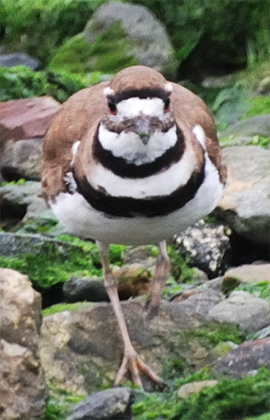

There were many different kinds of songbirds nesting in the woods. These birds migrate into the Chicago area from the south in large flocks each spring. Sometimes the migrating flocks can include hundreds of thousands of all different kinds of birds. They migrate mainly at night. The skyscrapers in downtown Chicago, when lit at night, kill thousands of migrating birds each year. The Milwaukee Bucks basketball team recently got an award for the inclusion of architectural features into their new stadium which lessen the probablity of bird collisions.
The spring migration north takes place usually from late March into May. When the weather gets warm, the birds fly north from as far as South America and as near as the Gulf Coast. Some of them go all the way up to the Arctic Ocean. The birds come north because the days are longer in the summer than they are in the south and, most importantly, there is an abundance of food. The woods are literally crawling with insects and the ponds are full of fish and other tasty creatures like frogs and crayfish. When the days start getting shorter in late summer, insects become less abundant, and their babies are grown enough to fly, they start heading south. Southbound migration starts in July and can go on through October.
I saw two different kinds of Warblers nesting in the area, especially near the edges of ponds. Yellow Warblers with their red striped breasts and Common Yellowthroats with their black masks.


The Yellowthroats were very widespread in the area. I heard their witchu-witchu calls many more times than I saw them. They were nesting in the cattails along the street by the Peace church off 131st St. Warblers seem to be more active early in the morning than they are during the rest of the day.



There were many Gray Catbirds nesting in the woods along 104th Ave. They actually make a meow sound when they are alarmed. You will hear them more than you will see them.
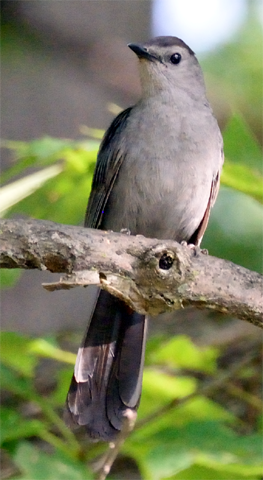

Blue Jays are a resident bird in the woods along 104th Ave. They were patrolling the woods in small loud roving groups. Jays bully smaller birds. Among other things, they eat eggs and nestlings. You will see them in the winter as well as summer. In tests run by researchers, Jays appear to be more intelligent than most other birds. They may visit bird feeders.

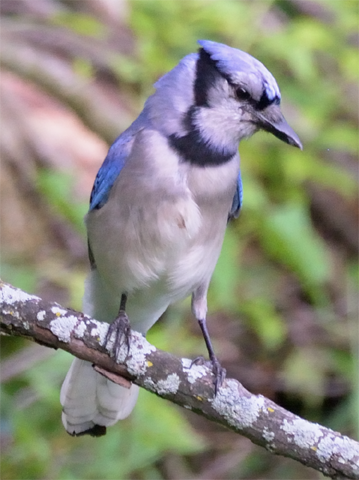
Indigo Buntings were nesting in a lot of places near the edges of the forest. They are not “Bluebirds”. Buntings are related to the red Cardinals that you can see flying back and forth across the Peace Lagoon.


There were Bluebirds nesting in boxes which were installed by the Forest Preserve District. Bluebirds have thinner bills than Buntings. The bill on a bird gives an indication of what they eat. Buntings rely on seeds for food much more than the Bluebirds which eat mainly insects and spiders. The female Bluebird is standing on top of the nest box while the male is feeding their chicks. Bluebirds had been declining in numbers until a nationwide movement to install nest boxes started a number of years ago. Their population has increased since the nest boxes have been available. If you build them, they will come.


I saw some birds which were feeding on the trunks of trees. These included White-breasted Nuthatches along with Northern Flickers and Downy Woodpeckers. These birds remain in the area all year long and sometimes visit bird feeders. They especially like suet in the winter.





There were many birds in a group known as Flycatchers feeding actively, especially along the shores of ponds and wetlands. These birds chase flying insects and grab them out of the air. If you see a bird flying around like it’s crazy, it’s probably a flycatcher chasing a bug. The images below are of the ones I saw: Willow Flycatcher, Wood-Peewee, Great Crested Flycatcher and Phoebe. Their bills are designed for plucking insects out of the air. You may see any of these feeding along the edges of the Peace Lagoon.




I saw a couple of Baltimore Orioles in the woods near the Little Red Schoolhouse. Orioles are closely related to black birds. I also saw some Warbling Vireos feeding in the trees near the larger ponds.



Blue-gray Gnatcatchers were nesting in the woods near ponds. The male hunts insects while the female sits on her nest and incubates her eggs.


American Goldfinches were common all over the area. They were feeding in most of the fields along 104th Ave and around Peace. In many species of birds, it’s hard to tell males from females because they look pretty much alike. The American Goldfinch is a type of bird in which the males and females look a little different. Males have black crowns and are a bright yellow color. Females are duller colored. This makes them look a little less conspicuous when they are sitting in their nest. Goldfinch will visit bird feeders.

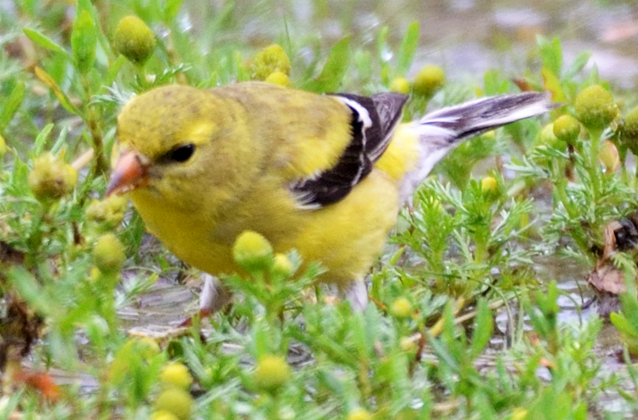
There were roving flocks of Black-capped Chickadees feeding in the woods. They stay for the winter and can be enticed to a well-stocked bird feeder when food becomes scarce. When feeding they are very energetic, jumping from tree to tree looking for seeds and insects.


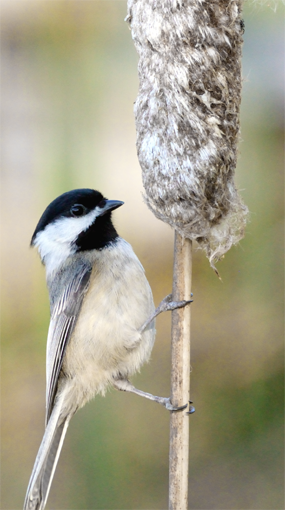
I saw a couple of small flocks of House Finch scattered in the woods. These are seed-eating birds. You can tell by looking at their beak. Males are red, females and young birds are striped. These birds will return to a feeder once they have found it. They stay in the area through the winter.



I saw a few different kinds of Sparrows, mainly in or near open fields. All Sparrows have the same general shape, brownish color, and a beak which is good for cracking seeds. The images below show a Field Sparrow eating a grasshopper; a Savannah Sparrow with a yellow eyebrow; a Swamp Sparrow with a rusty crown; and a Song Sparrow singing.
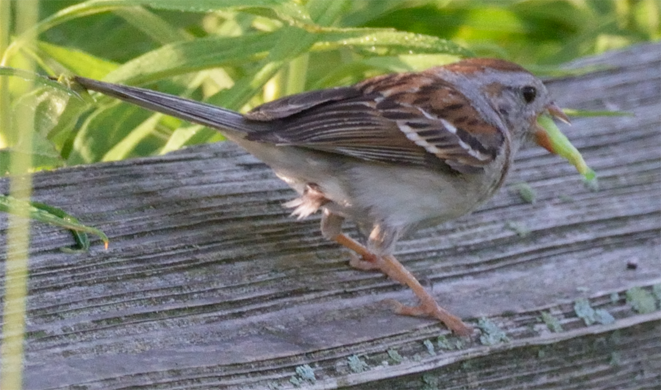



There were House Sparrows nesting in the nooks and crannies of the buildings at Peace. House Sparrows have lived around humans for centuries. A flock from England was introduced into Brooklyn, New York in 1851 to control insect pests. By 1900 they had spread to the Rocky Mountains. Two more introductions in the early 1870s, in San Francisco and Salt Lake City, aided the bird’s spread throughout the country. House Sparrows are now common across North America except Alaska and far northern Canada. Many birders consider them nuisances. They displace native birds from their nest sites and gobble up their food and nestlings. This is how they have spread so far beyond their original home in Europe and the Middle East to become the most widespread bird in the world. Males have black masks around their eyes and a prominent stripe on their heads; females and young birds have less prominent head markings.


There were quite a few Robins nesting in the woods near Peace and along 104th Ave. Robins are in the Thrush family. Thrushes spend a lot of time feeding on the ground. The Robin is a very familiar bird to most people. The young birds look a little different from older birds. Robins have been known to get staggering drunk after eating too many fermented berries. In the years when the 17-year cicadas emerge from the earth, Robins can gorge themselves so much that they are unable to fly.



I saw a couple of different kinds of Swallows in the area. These are the birds that zip back and forth over the surface of the lagoon. You may also see them sitting on telephone wires. Swallows fly swiftly and erratically with their mouths open to catch insects on the fly. On summer evenings you can see swarms of small insects over the lagoon. Many of the insects have just hatched. Swallows fly through the swarms feeding on the insects with their mouths open like vacuum cleaners.
Barn Swallows were nesting in the eaves of a few of the picnic areas in the woods along 104th Ave. Along with the other types of swallows, they migrate all the way to South America in late summer as the days grow shorter and their babies are big enough to fly. They feed on the wing as they migrate. Barn Swallows have forked tails.



The Barn Swallow chicks grew fast. The images below were taken a few days apart. Same birds in each picture. You can see the change from the downy feathers that formed first into their initial set of real feathers. New feathers start as pin-like objects and gradually turn into a feather with a stem and vanes.


Tree Swallows were numerous around open fields and ponds. Many were nesting in boxes set up by the Forest Preserve District, others were nesting in cavities of trees. Tree Swallows don't have forked tails like Barns Swallows.




There were three kinds of blackbirds feeding mainly at the north end of Peace Lagoon – Brown-Headed Cowbirds, Red-Winged Blackbirds and Common Grackles. They were probably nesting near the lagoon. I saw them nesting in many places along the edges of the ponds along 104th Ave. Individuals of the same species of blackbird can look very different from each other. To the untrained eye they appear to be different species.
Male Brown-Headed Cowbirds have brown heads. Females and young birds do not. Female Cowbirds lay their eggs in other birds' nests and let the other bird raise their chicks. There are a few different kinds of birds that do that. Sometimes the female bird feeding the cowbird chick is smaller than the chick.



Mature male Red-winged Blackbirds have red on their wings; younger males are brownish-black without red epaulets; and females are striped.




Common Grackles are larger than the other two blackbirds. They have large beaks and tails, yellow eyes and are iridescent when the sunlight hits them a certain way.


House Wrens were fairly common in the area. These are small brown very elusive birds that flit through the undergrowth. A pair was nesting in a box that was installed by the Forest Preserve District near the Little Red Schoolhouse. You’ll hear their melodious songs much more than you’ll see them.

The cooo-coooo-cooooing that you hear during the day is probably not an owl. It is most likely a Mourning Dove, the pigeon’s cousin. They are very widespread in the area as they are throughout the country.

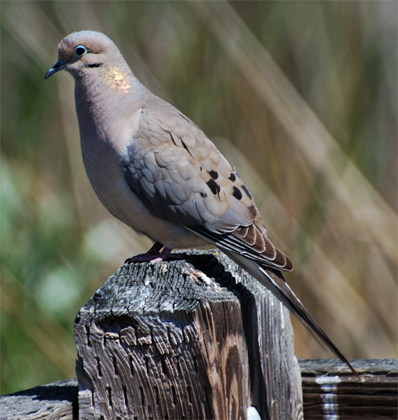
I saw an Osprey flying over the lagoon. These are hawks that eat mainly fish. As a result, they are sometimes called “Fish Hawks”. There was a nest in the middle of the pond by the Little Red Schoolhouse and another on the south shore of Saganashkee Slough. Both nesting sites were platforms installed by the Forest Preserve District. The Osprey is very widespread. They are found throughout the world where ever there are enough fish to survive.





I also saw a couple of Red-tailed Hawks fly by near Peace. These are fairly common throughout the year in the Chicago region. Red-tails have a large variety in the patterns of their feathers. Sometimes they can look very different from one to another, but they are still the same species of bird. They may look different but their shape is always the same

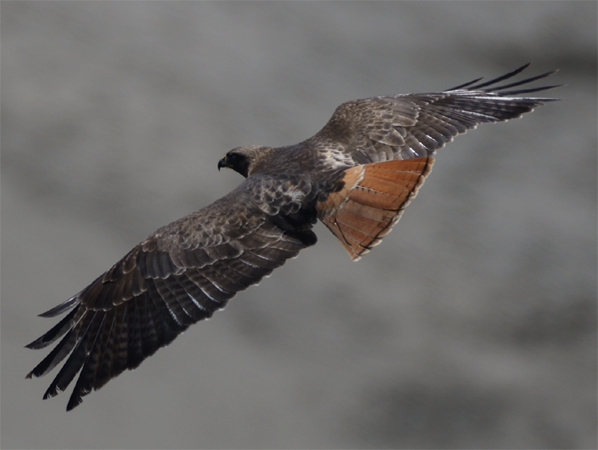
I saw many Turkey Vultures. Most of them were soaring way up in the sky. They follow the rising air in the summertime and reach great heights – well over a thousand feet – then they begin to soar. They can cover over a hundred miles a day. They are usually seen hundreds of feet in the air wobbling along with the wind. These birds look like hawks, but most hawks soar with their wings straight out in a horizontal line. Vultures soar with their wings in a slight V-shape. They get blown back and forth by the air currents. Hawks usually don’t wobble in the wind like Vultures. Vultures are nature’s scavengers, feeding mainly on roadkill and other animals that have died naturally. They hunt mainly by smell and can smell a dead creature from over a mile away. Bird rescue people say they are very gentle birds compared to the hawks and owls.
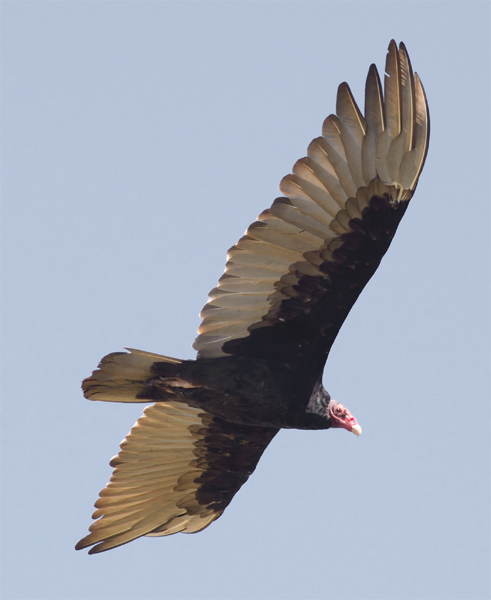


Birds have a lot of feathers. A big goose can have 25,000 individual feathers. Small downy feathers cover their bodies to keep them warm at night. Longer and stronger feathers help the bird fly and maneuver. Some birds grow very colorful feathers for part of the year to attract mates. Songbirds can have a few thousands of feathers; ducks over 10,000; hawks average around 8,000 feathers. With few exceptions, birds lose and regrow all their feathers at least once a year. The process of replacing feathers is called molt. Some birds molt twice or more each year. I saw Wood Ducks which were molting from juvenile plumage into adult plumage. Wood Ducks were nesting on a lot of the ponds along 104th Ave.


Mallards were nesting on many of the ponds. Mallards are some of the most common birds across the world. As in many ducks, the males and females look different. The female is camouflaged to blend into her nest site. The male's head grades from green to dark blue depending on their age and how the sunlight is hitting the feathers.

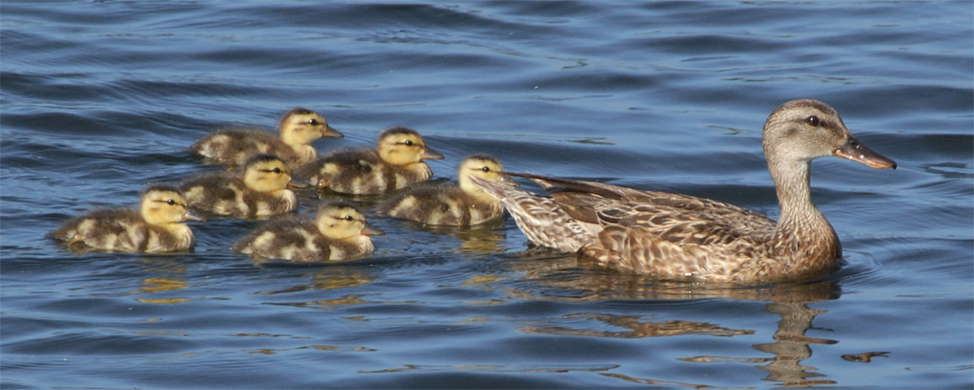
There were many Canada Geese in the area. Perhaps too many in some places. Canada Geese have become a nuisance in recent years as they adopt a more suburban, less rural lifestyle.

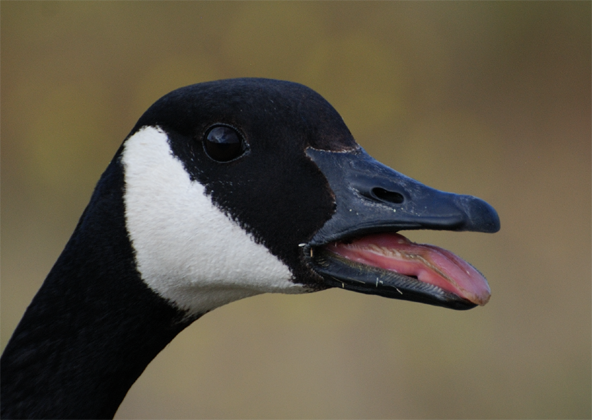

Palos Birds Checklist © 2019 Steve Eckert email